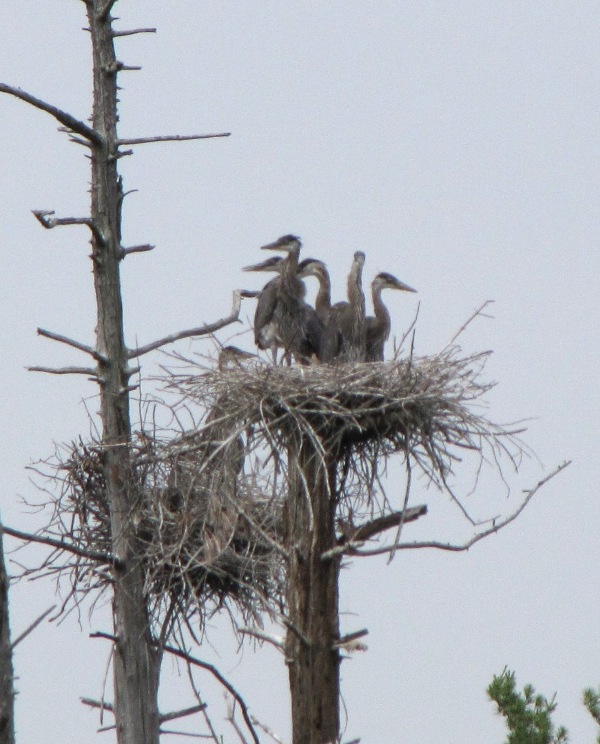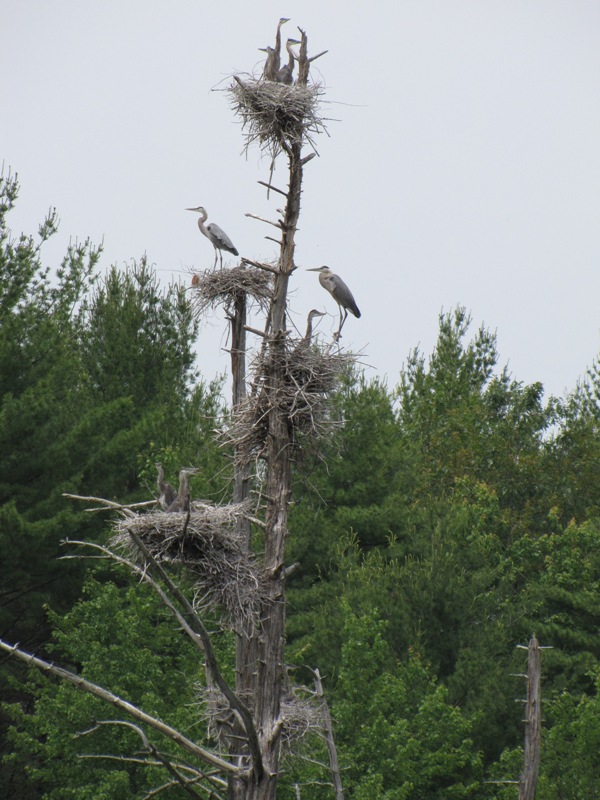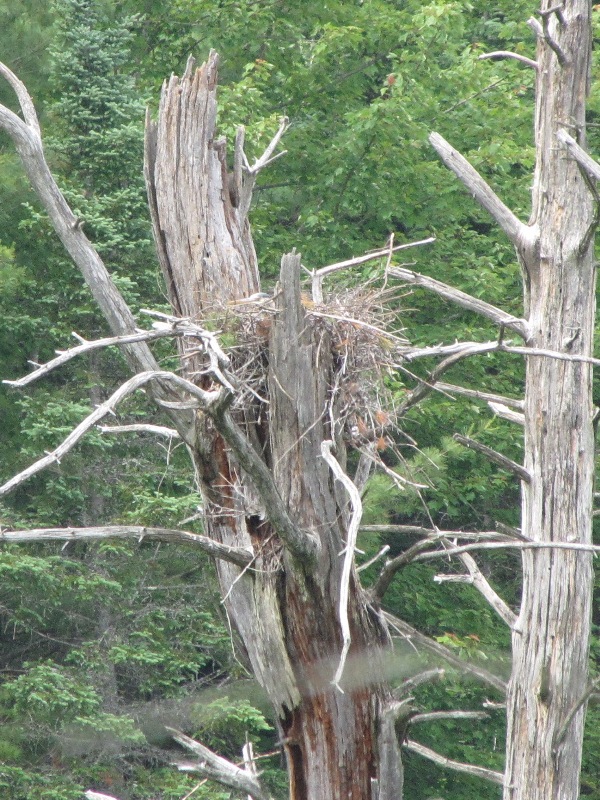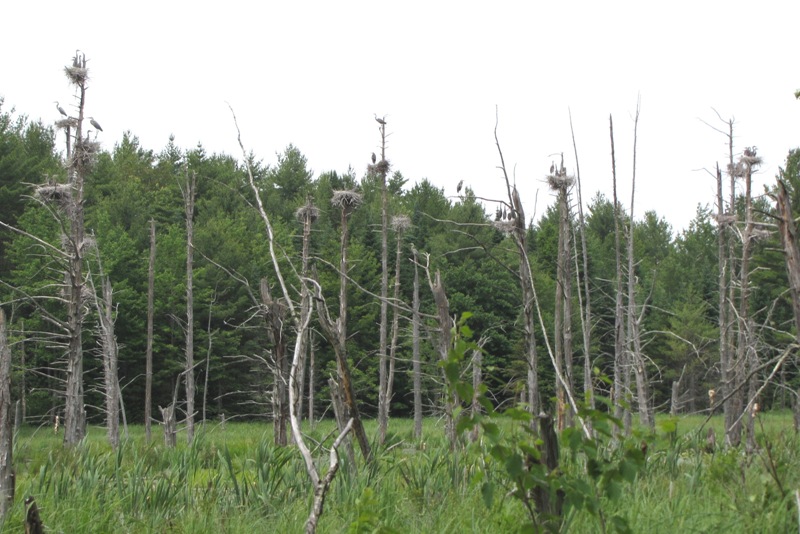June 23, 2010 at 1:32 pm
[caption id="attachment_344" align="alignleft" width="241" caption="Five nestlings, all around 4-5 weeks old."] [/caption]
[Be sure to click on a photo for a larger view.]
Can you imagine raising 5 children in a 1-room apartment? For great blue herons, it’s not all that uncommon. In general, great blue herons lay 2-7 eggs, but I have yet to see more than 5 young in any nest. I, along with many HERON volunteers, have remarked on the abundance of nestlings this year. In a recent visit to a colony, I counted 87 nestlings in 32 nests! And, those were the nestlings I could see…some nestlings were likely hunkered down in the nest or behind a branch out of my view.
[caption id="attachment_349" align="alignleft" width="225" caption="From top to bottom: 4 nestlings, 4-6 wks old; 1 adult & 1 nestling, 2-4 wks old; 1 adult & 1 nestling, 4-6 wks old; 4 nestlings, 4-6 wks old; 2 nestlings, 4-6 wks old."]
[/caption]
[Be sure to click on a photo for a larger view.]
Can you imagine raising 5 children in a 1-room apartment? For great blue herons, it’s not all that uncommon. In general, great blue herons lay 2-7 eggs, but I have yet to see more than 5 young in any nest. I, along with many HERON volunteers, have remarked on the abundance of nestlings this year. In a recent visit to a colony, I counted 87 nestlings in 32 nests! And, those were the nestlings I could see…some nestlings were likely hunkered down in the nest or behind a branch out of my view.
[caption id="attachment_349" align="alignleft" width="225" caption="From top to bottom: 4 nestlings, 4-6 wks old; 1 adult & 1 nestling, 2-4 wks old; 1 adult & 1 nestling, 4-6 wks old; 4 nestlings, 4-6 wks old; 2 nestlings, 4-6 wks old."] [/caption]
A great blue heron nest does not appear to be the most solidly built structure. They often look like they are on the verge of falling apart or being blown from the nest tree with the next gust of wind over 10 mph. However, somehow they manage to withstand the nastiest of spring storms, and usually persist on through the following winter enduring wind, rain, ice, and snow. A newly built nest can be quite flimsy and may not measure more than 20 inches across, whereas a nest that has been reused for many years (and rebuilt each year), may appear more bulky and measure 45 inches across with a depth of 40 inches.
The average nest probably has the same dimensions of the average tire of a 4-door sedan. Now picture 5 nestlings at 6-8 weeks old, each 2 feet tall and about 4.5 lbs each standing in a tire made of sticks! These long-legged, long-necked birds share this nest from the day they hatch until they are ready to fly approximately 70-80 days later! Talk about very little elbow (or wing) room.
[caption id="attachment_354" align="alignleft" width="225" caption="Look closely for the yellow bill and black and white head of the incubating adult in this picture."]
[/caption]
A great blue heron nest does not appear to be the most solidly built structure. They often look like they are on the verge of falling apart or being blown from the nest tree with the next gust of wind over 10 mph. However, somehow they manage to withstand the nastiest of spring storms, and usually persist on through the following winter enduring wind, rain, ice, and snow. A newly built nest can be quite flimsy and may not measure more than 20 inches across, whereas a nest that has been reused for many years (and rebuilt each year), may appear more bulky and measure 45 inches across with a depth of 40 inches.
The average nest probably has the same dimensions of the average tire of a 4-door sedan. Now picture 5 nestlings at 6-8 weeks old, each 2 feet tall and about 4.5 lbs each standing in a tire made of sticks! These long-legged, long-necked birds share this nest from the day they hatch until they are ready to fly approximately 70-80 days later! Talk about very little elbow (or wing) room.
[caption id="attachment_354" align="alignleft" width="225" caption="Look closely for the yellow bill and black and white head of the incubating adult in this picture."] [/caption]
The nestlings I saw last week varied quite a bit in age. Several nests had nestlings that were still small and fuzzy indicating they were probably only 1-2 weeks old. But, most of the nests contained nestlings that were large, with little to no fuzz, and standing quite tall making it more difficult to differentiate them from the adults. There was even one nest with an adult in incubation posture, hunkered down so low that only its head was visible. This is probably a pair attempting to nest again after an initial failed attempt.
A heron colony at this time of year is quite an active and noisy place! Adults are constantly coming and going with food for their young. The approach of an adult is always met with excitement. The young vocalize with a sound that resembles them clapping their mandibles together, but their mouths are actually open while they produce this chattering noise. An adult will stand in the nest while the young all simultaneously try to grasp its bill with theirs. This tug-of-war stimulates the adult to regurgitate food into the nestling mouths, or in the case of older nestlings, directly into the nest. The nestlings then scramble to get their fair share.
[caption id="attachment_357" align="alignleft" width="300" caption="Only half of the active nests at this colony are in view in this picture."]
[/caption]
The nestlings I saw last week varied quite a bit in age. Several nests had nestlings that were still small and fuzzy indicating they were probably only 1-2 weeks old. But, most of the nests contained nestlings that were large, with little to no fuzz, and standing quite tall making it more difficult to differentiate them from the adults. There was even one nest with an adult in incubation posture, hunkered down so low that only its head was visible. This is probably a pair attempting to nest again after an initial failed attempt.
A heron colony at this time of year is quite an active and noisy place! Adults are constantly coming and going with food for their young. The approach of an adult is always met with excitement. The young vocalize with a sound that resembles them clapping their mandibles together, but their mouths are actually open while they produce this chattering noise. An adult will stand in the nest while the young all simultaneously try to grasp its bill with theirs. This tug-of-war stimulates the adult to regurgitate food into the nestling mouths, or in the case of older nestlings, directly into the nest. The nestlings then scramble to get their fair share.
[caption id="attachment_357" align="alignleft" width="300" caption="Only half of the active nests at this colony are in view in this picture."] [/caption]
The tough reality is that tight living quarters and competition for food amongst several siblings makes for a high probability that not all will thrive and survive to full flight stage. Even so, the colony I visited last week will likely fledge around 40 herons within a month…and all will face the new challenge of surviving on their own.
[/caption]
The tough reality is that tight living quarters and competition for food amongst several siblings makes for a high probability that not all will thrive and survive to full flight stage. Even so, the colony I visited last week will likely fledge around 40 herons within a month…and all will face the new challenge of surviving on their own.
 [/caption]
[Be sure to click on a photo for a larger view.]
Can you imagine raising 5 children in a 1-room apartment? For great blue herons, it’s not all that uncommon. In general, great blue herons lay 2-7 eggs, but I have yet to see more than 5 young in any nest. I, along with many HERON volunteers, have remarked on the abundance of nestlings this year. In a recent visit to a colony, I counted 87 nestlings in 32 nests! And, those were the nestlings I could see…some nestlings were likely hunkered down in the nest or behind a branch out of my view.
[caption id="attachment_349" align="alignleft" width="225" caption="From top to bottom: 4 nestlings, 4-6 wks old; 1 adult & 1 nestling, 2-4 wks old; 1 adult & 1 nestling, 4-6 wks old; 4 nestlings, 4-6 wks old; 2 nestlings, 4-6 wks old."]
[/caption]
[Be sure to click on a photo for a larger view.]
Can you imagine raising 5 children in a 1-room apartment? For great blue herons, it’s not all that uncommon. In general, great blue herons lay 2-7 eggs, but I have yet to see more than 5 young in any nest. I, along with many HERON volunteers, have remarked on the abundance of nestlings this year. In a recent visit to a colony, I counted 87 nestlings in 32 nests! And, those were the nestlings I could see…some nestlings were likely hunkered down in the nest or behind a branch out of my view.
[caption id="attachment_349" align="alignleft" width="225" caption="From top to bottom: 4 nestlings, 4-6 wks old; 1 adult & 1 nestling, 2-4 wks old; 1 adult & 1 nestling, 4-6 wks old; 4 nestlings, 4-6 wks old; 2 nestlings, 4-6 wks old."] [/caption]
A great blue heron nest does not appear to be the most solidly built structure. They often look like they are on the verge of falling apart or being blown from the nest tree with the next gust of wind over 10 mph. However, somehow they manage to withstand the nastiest of spring storms, and usually persist on through the following winter enduring wind, rain, ice, and snow. A newly built nest can be quite flimsy and may not measure more than 20 inches across, whereas a nest that has been reused for many years (and rebuilt each year), may appear more bulky and measure 45 inches across with a depth of 40 inches.
The average nest probably has the same dimensions of the average tire of a 4-door sedan. Now picture 5 nestlings at 6-8 weeks old, each 2 feet tall and about 4.5 lbs each standing in a tire made of sticks! These long-legged, long-necked birds share this nest from the day they hatch until they are ready to fly approximately 70-80 days later! Talk about very little elbow (or wing) room.
[caption id="attachment_354" align="alignleft" width="225" caption="Look closely for the yellow bill and black and white head of the incubating adult in this picture."]
[/caption]
A great blue heron nest does not appear to be the most solidly built structure. They often look like they are on the verge of falling apart or being blown from the nest tree with the next gust of wind over 10 mph. However, somehow they manage to withstand the nastiest of spring storms, and usually persist on through the following winter enduring wind, rain, ice, and snow. A newly built nest can be quite flimsy and may not measure more than 20 inches across, whereas a nest that has been reused for many years (and rebuilt each year), may appear more bulky and measure 45 inches across with a depth of 40 inches.
The average nest probably has the same dimensions of the average tire of a 4-door sedan. Now picture 5 nestlings at 6-8 weeks old, each 2 feet tall and about 4.5 lbs each standing in a tire made of sticks! These long-legged, long-necked birds share this nest from the day they hatch until they are ready to fly approximately 70-80 days later! Talk about very little elbow (or wing) room.
[caption id="attachment_354" align="alignleft" width="225" caption="Look closely for the yellow bill and black and white head of the incubating adult in this picture."] [/caption]
The nestlings I saw last week varied quite a bit in age. Several nests had nestlings that were still small and fuzzy indicating they were probably only 1-2 weeks old. But, most of the nests contained nestlings that were large, with little to no fuzz, and standing quite tall making it more difficult to differentiate them from the adults. There was even one nest with an adult in incubation posture, hunkered down so low that only its head was visible. This is probably a pair attempting to nest again after an initial failed attempt.
A heron colony at this time of year is quite an active and noisy place! Adults are constantly coming and going with food for their young. The approach of an adult is always met with excitement. The young vocalize with a sound that resembles them clapping their mandibles together, but their mouths are actually open while they produce this chattering noise. An adult will stand in the nest while the young all simultaneously try to grasp its bill with theirs. This tug-of-war stimulates the adult to regurgitate food into the nestling mouths, or in the case of older nestlings, directly into the nest. The nestlings then scramble to get their fair share.
[caption id="attachment_357" align="alignleft" width="300" caption="Only half of the active nests at this colony are in view in this picture."]
[/caption]
The nestlings I saw last week varied quite a bit in age. Several nests had nestlings that were still small and fuzzy indicating they were probably only 1-2 weeks old. But, most of the nests contained nestlings that were large, with little to no fuzz, and standing quite tall making it more difficult to differentiate them from the adults. There was even one nest with an adult in incubation posture, hunkered down so low that only its head was visible. This is probably a pair attempting to nest again after an initial failed attempt.
A heron colony at this time of year is quite an active and noisy place! Adults are constantly coming and going with food for their young. The approach of an adult is always met with excitement. The young vocalize with a sound that resembles them clapping their mandibles together, but their mouths are actually open while they produce this chattering noise. An adult will stand in the nest while the young all simultaneously try to grasp its bill with theirs. This tug-of-war stimulates the adult to regurgitate food into the nestling mouths, or in the case of older nestlings, directly into the nest. The nestlings then scramble to get their fair share.
[caption id="attachment_357" align="alignleft" width="300" caption="Only half of the active nests at this colony are in view in this picture."] [/caption]
The tough reality is that tight living quarters and competition for food amongst several siblings makes for a high probability that not all will thrive and survive to full flight stage. Even so, the colony I visited last week will likely fledge around 40 herons within a month…and all will face the new challenge of surviving on their own.
[/caption]
The tough reality is that tight living quarters and competition for food amongst several siblings makes for a high probability that not all will thrive and survive to full flight stage. Even so, the colony I visited last week will likely fledge around 40 herons within a month…and all will face the new challenge of surviving on their own.Categories